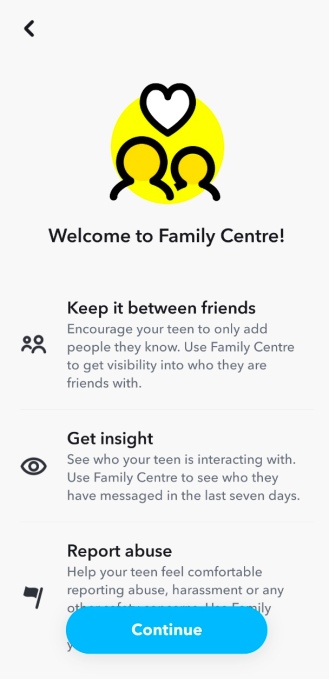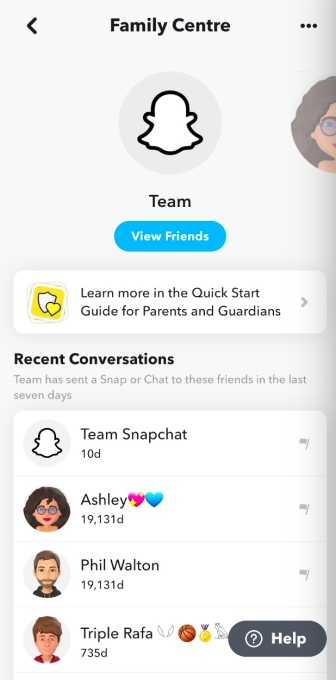Snapchat is preparing to introduce a new parental control feature dubbed “Family Center,” which will allow parents to see who their teen is friends with on the app as well as who they’ve been messaging with over the past seven days, and more.
Snap’s CEO Evan Spiegel first teased the planned offering during an interview in October, where he explained the feature would give parents better visibility into how teens use its service and, hopefully, make them feel more comfortable with the app.
Snap is one of the last Big Tech social platforms to address the need for parental monitoring tools, though its app sees heavy use among younger users. At Snap’s NewFronts presentation to advertisers earlier this month, the company noted the Snapchat app now reaches more than 75% of 13-34-year-olds in over 20 countries, and 80% of the U.S. Gen Z population had watched at least one of its Snap Original shows.
According to new screenshots of Snapchat’s forthcoming Family Center shared with TechCrunch by the product intelligence firm Watchful, the new Family Center feature allows parents to see who their teen is friends with on the app. This is useful for parents because, unlike many social networks, Snapchat’s friend lists aren’t public. Parents will also have visibility into who their teen has chatted with over the past seven days — but not the contents of those conversations. The screenshots additionally explain that parents will be able to assist their teen in reporting abuse and harassment, if needed.

Image Credits: Snapchat screenshot via Watchful
The parental control feature works by allowing parents to invite their teen (or teens) to the new in-app Family Center in order to begin the monitoring. The recipient of that invitation has the option of either accepting or declining the invitation.
This is, arguably, an appropriate approach to parental controls involving teens, as it respects their privacy. Instead of allowing parents to surreptitiously spy on their teens, it ensures the parent and child will instead have a conversation about parental monitoring, where they agree to a set of rules appropriate for their own household.
The images provided by Watchful represent early designs of Snapchat’s feature, which is still in development and not yet live or being tested. We should note that products at this stage often change before their launch to the general public. That means the final product could look quite different. (The U.K. spelling of the word “Center,” too, suggests that we’re not seeing a global version of the Family Center product here.)

Image Credits: Snapchat screenshot via Watchful
Other large social platforms have already launched their parental control features and other age-appropriate experiences for their younger users. Snap is running a little behind.
TikTok, for example, has continued to develop its parental controls offerings following the debut of its in-app Family Pairing tool back in 2020. The tool allows parents to pair their TikTok account with a child’s in order to control the account’s privacy, whether it’s suggested to other TikTok users, whether the child can use search, and who, if anyone, can view, comment or interact with the child’s content, among other things. There’s also a toggle to put the account into an even safer mode for under-13 users.
YouTube also launched parental control features into testing last year that allow parents to select between different levels of YouTube access for teen or tween users. And Instagram arrived even later with its new safety tools for parents, also called Family Center, which didn’t roll out until March 2022. Its tools let parents monitor time spent on the app, who has followed the child’s account and more.
Although all platforms compete broadly in the social media space, they all operate a bit differently, which informs what type of parental control features are actually needed. In Snapchat’s case, minors on the app have to mutually accept each other as friends before they can begin messaging. Minors’ accounts also aren’t shown in search results or as friend suggestions to another user — unless they have friends in common. And minors are not able to have public profiles. That means Snap wouldn’t need to roll out parental control features to control these types of experiences.
Snap declined to comment on the Family Center screenshots, but the company had previously said the offering would arrive in the coming months.

